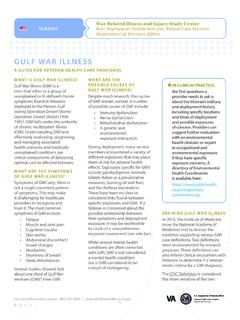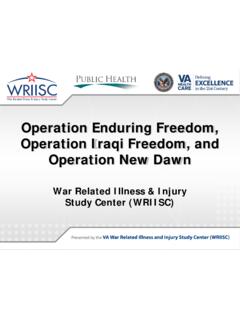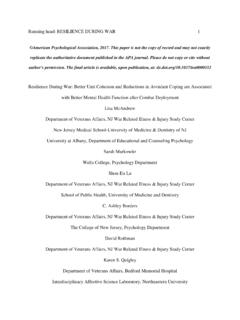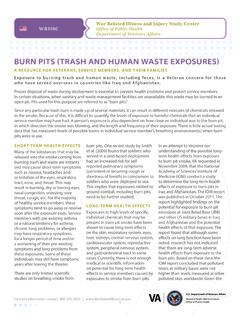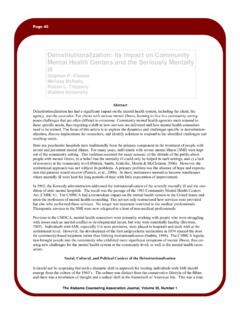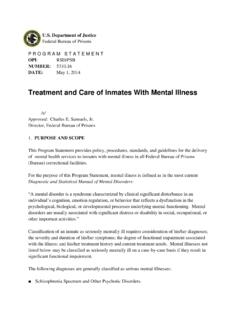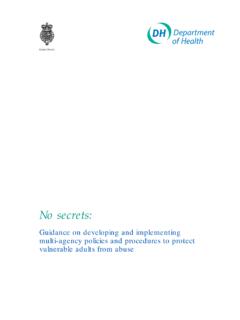Transcription of Operation Desert Shield/Desert Storm - War Related Illness ...
1 Operation Desert shield / Desert Storm War Related Illness & Injury Study Center Objectives The purpose of this WRIISC group post-deployment exposure education visit is to: Inform Veterans of potential health hazards that may be Related to certain conflicts and military activities Increase Veterans' awareness of VA's post- deployment health resources and activities Presentation Outline Introduction Potential Exposures Health Effects VA Health Care Other VA Resources Department of Veterans Affairs Department of Veterans Affairs Veterans Health Veterans Benefits National Cemetery Administration Administration Administration (Hospitals and Clinics). Who are we at WRIISC? We are a 2nd opinion referral center for combat Veterans with difficult to diagnose illnesses We provide education to Veterans and health care providers on post- deployment health concerns We conduct clinical research on issues Related to post-deployment and Veterans' health Ground Troop Movements: 24-28 Feb 1991.
2 Ground Troop Movements 24-28 February 1991. Potential ODSS Exposure Concerns CARC Paint Loud noises Chemical and Biological Oil Well Fires, Smoke, and Weapons Petroleum Depleted Uranium Pesticides Harsh living conditions Physical and Mental Stressors Incoming fire, explosive events Pyridostigmine Bromide Industrial solvents and Sand, Dust, Airborne chemicals Particulate Matter Infections Vaccinations Injuries, musculoskeletal wear and tear REF: WRIISC Clinical Reports Gulf War Locator Map United States Army Public Health Command: Provides estimates of oil well fire smoke exposure Public Law 102-4. Public Law 102-4. (Agent Orange Act of 1991). Provides the foundation to allow VA to obtain independent scientific review of evidence regarding associations between diseases and exposures. Established presumption of exposure & service connection for diseases.
3 Institute of Medicine reviews Gulf War research and makes scientific recommendations to VA. What are presumptions and why do we have them? Lack of reliable exposure data and specific causal evidence Two-step presumption: If you were there You were exposed If you were exposed and develop one of the conditions It is Related to the exposure Gulf War Associated Conditions Infectious Disease: VA presumes the following infectious diseases are Related to military service in the Southwest Asia theater of operations during the first Gulf War starting August 2, 1990, through the conflict in Iraq and on or after September 19, 2001, in Afghanistan. Veterans must have the disease(s) within the time frames shown here and have a current disability as a result of that disease in order to receive VA disability compensation. REF: Gulf War Associated Conditions Infectious Disease: Malaria: An infectious disease caused by a parasite transmitted by mosquitoes.
4 Symptoms include chills, fever, and sweats. It must be at least 10 percent disabling within one year from the date of military separation or at a time when standard or accepted treatises indicate that the incubation period began during a qualifying period of military service. Brucellosis: A bacterial disease with symptoms such as profuse sweating and joint and muscle pain. The Illness may be chronic and persist for years. It must be at least 10 percent disabling within one year from the date of military separation. Campylobacter Jejuni: A disease with symptoms such as abdominal pain, diarrhea, and fever. It must be at least 10 percent disabling within one year from the date of military separation. REF: Gulf War Associated Conditions Infectious Disease: Coxiella Burnetii (Q Fever): A bacterial disease with symptoms such as fever, severe headache, and gastrointestinal problems such as nausea and diarrhea.
5 In chronic cases, the Illness may cause inflammation of the heart. It must be at least 10 percent disabling within one year of the date of military separation. Mycobacterium Tuberculosis: An Illness that primarily affects the lungs and causes symptoms such as chest pain, persistent cough (sometimes bloody), weight loss and fever. Nontyphoid Salmonella: A condition characterized by symptoms such as nausea, vomiting, and diarrhea. It must be at least 10 percent disabling within one year of the date of military separation. REF: Gulf War Associated Conditions Infectious Disease: Shigella: A condition characterized by symptoms such as fever, nausea, vomiting, and diarrhea. It must be at least 10 percent disabling within one year of the date of military separation. Visceral Leishmaniasis: A parasitic disease characterized by symptoms such as fever, weight loss, enlargement of the spleen and liver, and anemia.
6 The condition may be fatal if left untreated. West Nile Virus: A disease spread by mosquitoes characterized by symptoms such as fever, headache, muscle pain or weakness, nausea, and vomiting. Symptoms may range from mild to severe. It must be at least 10 percent disabling within one year from the date of military separation. REF: Gulf War Associated Conditions Medically Unexplained Chronic Symptoms: Some Gulf War Veterans experience medically unexplained chronic symptoms that can include fatigue, headaches, joint pain, indigestion, insomnia, dizziness, respiratory disorders, and memory problems. VA refers to these illnesses as "chronic multi-symptom Illness " and "undiagnosed illnesses." Does not use the term Gulf War Syndrome . when referring to medically unexplained symptoms reported by Gulf War Veterans. Why?
7 Because symptoms often vary widely among Veterans. REF: Chronic Multi-Symptom Illness Institute of Medicine definition: The presence of a spectrum of chronic symptoms experienced for 6 months or longer in at least two of six categories fatigue, mood and cognition, musculoskeletal, gastrointestinal, respiratory and neurologic that may overlap with but are not fully captured by known syndromes (such as irritable bowel syndrome, chronic fatigue syndrome, and fibromyalgia). REF: Gulf War Associated Conditions VA presumes certain chronic, unexplained symptoms existing for 6. months or more are Related to Gulf War service without regard to cause. These "presumptive" illnesses must have appeared during active duty in the Southwest Asia theater of military operations or by December 31, 2016, and be at least 10 percent disabling.
8 These illnesses include: Chronic Fatigue Syndrome: a condition of long-term and severe fatigue that is not relieved by rest and is not directly caused by other conditions. Fibromyalgia: a condition characterized by widespread muscle pain. Other symptoms may include insomnia, morning stiffness, headache, and memory problems. REF: Gulf War Associated Conditions Functional gastrointestinal disorders: a group of conditions marked by chronic or recurrent symptoms Related to any part of the gastrointestinal tract. Functional condition refers to an abnormal function of an organ, without a structural alteration in the tissues. Examples include irritable bowel syndrome (IBS), functional dyspepsia, and functional abdominal pain syndrome. Undiagnosed illnesses: symptoms that may include but are not limited to: abnormal weight loss, fatigue, cardiovascular disease, muscle and joint pain, headache, menstrual disorders, neurological and psychological problems, skin conditions, respiratory disorders, and sleep disturbances.
9 REF: Health Effects People respond to environmental exposures differently. The risk of developing health effects Related to an environmental exposure depends on many factors including: Chemicals to which you were exposed When you were exposed (as a fetus, child, adult). How much exposure you received How long you were exposed Your genes Any other exposures to environmental or occupational hazards you may have encountered during your lifetime Lifestyle choices (diet, tobacco or alcohol use, physical activity level). Illnesses you may have from other causes Medications taken during your lifetime REF: Post-Deployment Health Resources There are a number of resources to assist Veterans who have post-deployment health concerns including: Post-deployment Integrated Care Initiative (PDICI): Health care providers integrated with primary care who have post-deployment health expertise Environmental Health Clinicians and Registry Coordinators War Related Illness and Injury Study Center Evaluation If you have health concerns, it is important to talk to your primary care provider to see what type of work up might be indicated: History and Physical Examination Diagnostic evaluation based on presenting signs and symptoms of Veteran.
10 In some instances, further laboratory or diagnostic testing may be indicated. Toxicology tests often of limited value since they can not confirm remote exposures Depleted Uranium 24-hour urine test may be indicated GW Registry (includes OIF and OND), DU Registry and Upcoming Burn Pit Registry Why does VA have registries? How and where do Veterans get on the registries? What does a Veteran get from a health registry exam? Can a Veteran repeat the registry examination? Can Veteran family members receive health registry exams? Gulf War Registries Registries: Gulf War Registry: DU Registry Airborne Hazards and Open Burn Pit Registry Gulf War Review Newsletter Sign up for free at: Gulf War Review Newsletter PDF available at VA Environmental Health Coordinators Gulf War Registry (144,443 Veterans as of 1/21/14). Free, no-enrollment required Not a compensation examination Does not confirm exposure Provides an opportunity to discuss health concerns with a VA provider with knowledge of military specific exposures An outreach tool to connect Veterans with available resources Gulf War Exams by Year 30000.
